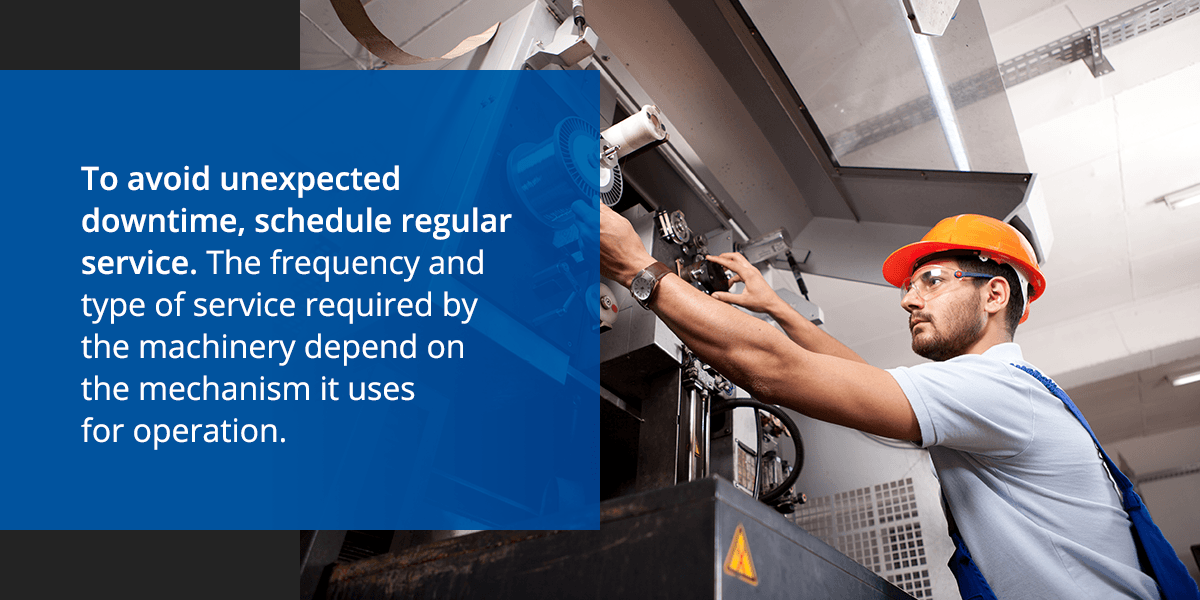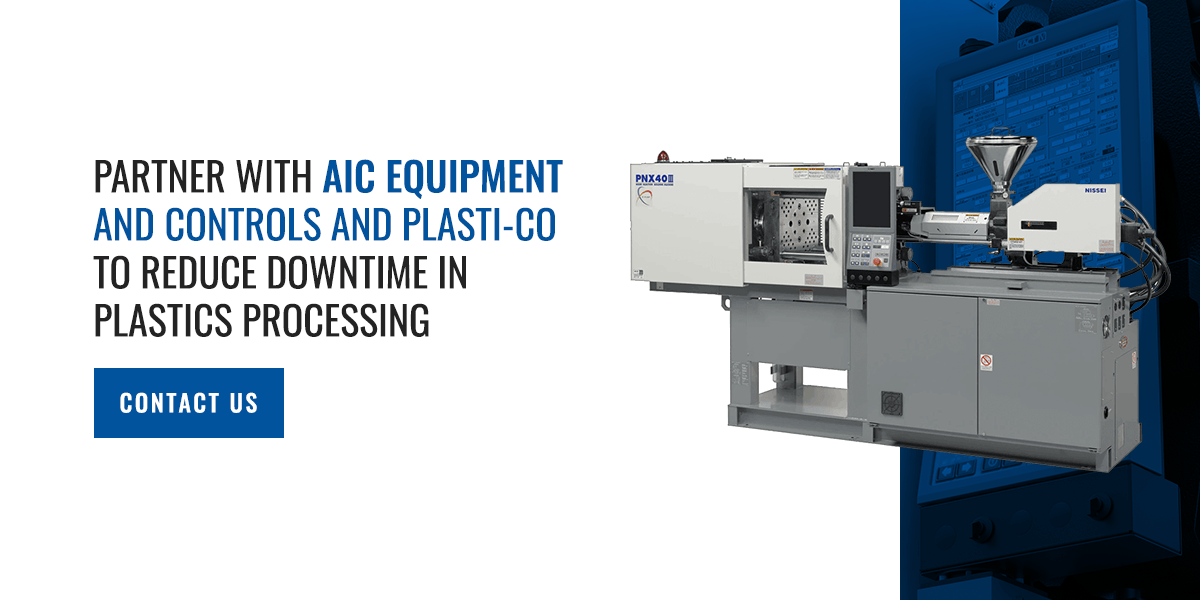Downtime in plastics manufacturing cuts into profits. Being proactive in reducing downtime benefits producers in multiple ways. Lead times drop, expensive repairs from machinery failure decrease and efficiency rises. With fewer delays, customer satisfaction increases. An investment in the people and parts needed to minimize molding machine downtime produces many returns in productivity gains.
8 Tips for Reducing Downtime in Plastics Manufacturing
You have multiple ways to keep injection molding machines up and running. By using several downtime-shrinking methods, you can optimize your production and minimize wasted time.
1. Allow Machines to Warmup
Operating machine cold forces the equipment to run at its most inefficient. Cold operation can also put strain on the machinery, increasing the chances of a premature failure. To avoid this scenario, plan for warmup time for all machines before using them.
2. Have Backup Parts on Hand for Repairs and Maintenance
Prepare for scheduled maintenance and unexpected repairs. Stock up on commonly used or replaced parts. When your facility has these parts ready, you reduce machine downtime. No longer do you have to wait for a delivery of a replacement part.
Some commonly replaced parts may include the following components:
- Heaters
- Thermocouples
- Feed screws
- Heater hookup wires
- Thermocouple wires
- Barrels
- Screw tip valve assemblies
- Nozzles
- End caps
The heating and cooling of plastic manufacturing machines puts all components under thermal stress. Though this stress can result in part failure, having a replacement piece on hand shortens the repair time to get the machine back up and running.
3. Service the Equipment at Regular Intervals
To avoid unexpected downtime, schedule regular service. The frequency and type of service required by the machinery depend on the mechanism it uses for operation. For instance, maintenance on hydraulic machines and electric or hybrid devices requires examinations of different components.
Hydraulic machines require operators to check the oil quality and level. Once a quarter, replace the oil filters for these hydraulic machines. Dirty oil does not keep the hydraulic system operating smoothly and efficiently. Dirty oil or a level too low can cause operating temperatures to rise, damaging the equipment.
Electric or hybrid machinery needs a close examination of their wiring. Any pinched or loose connections require correction. Plus, the electrical components must remain clean of dust. Annual cleaning of this portion of the machine can prevent dust from causing electrical problems.
Contact Us To Start Reducing Your Machine Downtime
4. Produce in Larger Batches Where Possible
If possible, plan to produce larger batches rather than several smaller ones. When producing multiple small batches, the equipment requires shutting down, recalibrating and warming up before beginning the next batch. This process increases downtime and wastes energy.
Producing a smaller number of larger batches cuts down on the time needed to reset the machine. Therefore, fewer batches of bulk orders will reduce downtime.
5. Use Predictive Maintenance
You should continue to conduct maintenance on the manufacturer’s suggested schedule. However, incorporating more high-tech predictive maintenance will also minimize molding machine downtime.
Predictive maintenance starts with monitoring the components of plastics manufacturing machinery for signs of wear. As the sensors note changes that indicate the part nears its failure point, the system alerts the operator to replace the part.
The problem with monitoring the state of screws is their location inside barrels. However, technology upgrades include software that can predict when to replace screws based on the molder’s operations. Timing screw replacement reduces downtime and maximizes the lives of screws.
6. Train Operators on the Correct Use of the Machinery
Because machinery failure does not always happen for mechanical reasons, you should pay close attention to your employees. Poor setup can strain the machinery, resulting in malfunctions, wasted time and discarded productions. Ensure all workers have proper training on setting up injection molding machines before using them.
While training workers on the setup for the machinery, make sure they know how to check the oil in a hydraulic system or to maintain an electrical system. Assigning basic maintenance tasks to operators can save technicians time and cut down on inefficient operation.
7. Understanding the Causes of Component Wear for Screws
When repairing or replacing components, the parts will fail again soon if you don’t understand why they wear down in the first place. Therefore, take time to examine replaced screws to spot causes of wear and determine how to mitigate them to reduce injection molding machine downtime.
The three most common causes of screw wear are improper screw design producing pressure differentials, incorrect barrel alignment and feeding abrasive fillers with the materials through the machine.
The screw design should allow for the plastic material to melt before moving it forward. However, if the plastic creates a temporary plug, pressure builds behind it, adding stress to the screw. Look at the flight on the screw. If you notice ragged edges on the lips of the flights, your screw may have produced uneven pressures that pushed it against the barrel. Replacing the screws with ones that completely melt the material before compressing it will solve this problem.
The second form of screw wear happens when the barrel expands from heat, causing the screw to rub against it. While this type of wear causes a very similar pattern to that from pressure changes, it extends over more of the screw. Replacing the barrel with a properly aligned one that doesn’t cause the screw to rub against it as it rotates may resolve this issue.
Lastly, using abrasive fillers can wear down the screw flights. However, these fillers don’t evenly wear the flight, instead, they round the edges of the flight and make it appear polished. Changing to less abrasive materials could prevent premature wear of screws that have this type of damage
8. Find Causes for Bridging and Other Problems
You should also identify the cause of bridging if you notice it occurring in your plastics manufacturing equipment. When plastic feed material clumps or sticks together, bridging occurs. When bridging happens, it blocks the feed throat, increases pressure below the clump and creates downtime by requiring an operator to clear the blockage. Two main causes of bridging occur, and solving the issues requires different approaches.
The less common reason behind bridging happens when the temperature in the feed throat is too high, causing individual particles to stick together into clumps.
This more common form of bridging occurs from worn components inside the machinery. Worn screws, barrels or non-return valves can all cause fully melted plastic to block the feed throat. Recognizing this issue and replacing the worn parts will solve the problem. Changing the feed throat temperature will not help.
Partner With AIC Equipment and Controls and Plasti-Co® to Reduce Downtime in Plastics Processing
Have the backup equipment that you need on hand to make fast repairs and get your plastics manufacturing machinery running again. Contact us at AIC Equipment and Controls and Plasti-Co® for your replacement parts that will help you reduce machine downtime in your facility.



